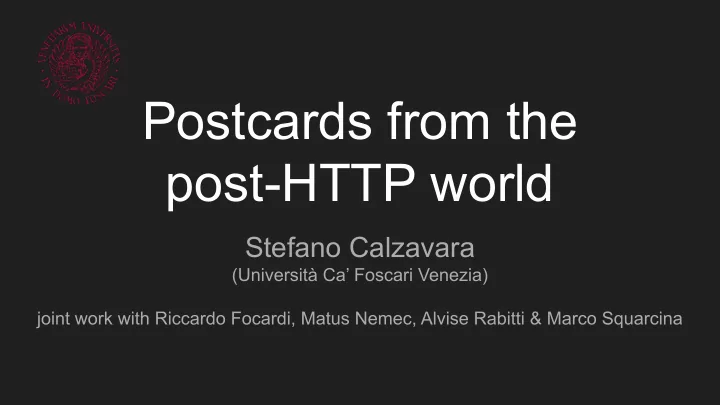

Postcards from the post-HTTP world Stefano Calzavara (Università Ca’ Foscari Venezia) joint work with Riccardo Focardi, Matus Nemec, Alvise Rabitti & Marco Squarcina
A dirge for HTTP ● The Web is fast evolving from HTTP to HTTPS ○ Trusted certificates issued for free by Let’s Encrypt ○ Major web browsers marking HTTP as insecure ○ Encrypted web traffic > Unencrypted web traffic since 2017 Yay! Safely use Wifi everywhere!
But can we trust HTTPS? ● Well, it’s much better than HTTP, but TLS has been attacked many times... Hey, these have been fixed on top sites… right?
Vulnerability amplification ● The security of any website depends on the security of many others ! ○ TLS vulnerabilities get amplified in the web ecosystem ○ Even a single TLS vulnerability might wreak havoc!!!
Contributions ● Review of existing attacks against TLS ○ Identified those still working in modern browsers ○ Characterized in terms of attack trees ● Analysis platform for web applications ○ Collects data for “relevant” hosts ○ Runs existing tools to build a security report ● Large-scale analysis of the Web ○ Page integrity (script injection) ○ Authentication credentials (cookies) ○ Web tracking ● First quantitative analysis of the impact of TLS vulnerabilities on web application security!
Attack trees for TLS security ● Attack trees ~ boolean formulas to express attack conditions ● Family of insecure channels ○ Tainted: allow MITM Goal: Learn the session keys (allows decryption) ○ Leaky: allow decryption 1 Decrypt RSA key exchange offline ○ Partially leaky: side-channels & 1 RSA key exchange is used | 1 RSA used in the highest TLS version ● Useful abstraction layer for web | 2 Downgrade to TLS version preferring RSA application (in-)security & 2 RSA decryption oracle available on: | 1 This host ● Full attack trees in the paper | 2 Host with the same certificate | 3 Host with the same public RSA key
Data collection ● Access www.example.com using Headless Chrome ● Collect the following information: ○ Serialized DOM ○ Cookies ○ Hosts serving sub-resources (scripts, images, etc.) ● Perform sub-domain enumeration on example.com ● Run existing TLS analysis tools on the collected hosts ● Map the output of the tools to the attack trees ● Build a security report 10k websites from Alexa ⇒ ~100k scanned hosts!
Preliminary statistics Exploitable TLS vulnerabilities in 5574 hosts (5.5%) Insecure channel Number of hosts Percentage Tainted 4818 4.8% Leaky 733 <1% Partially leaky 912 <1% RQ: How does this harm web application security?
Page integrity ● 898 homepages at danger of script injection due to tainted channels! ○ 660 cases due to remote script inclusion (~75%) ○ Ineffective adoption of Sub Resource Integrity (SRI) ● Popular script providers lead to vulnerability amplification! ○ 188 homepages harmed by Baidu ○ 126 homepages harmed by Linkedin
Cookies ● Cookies are the cornerstone of client authentication ● They can be set as host-only, but are often shared across sub-domains ● Confidentiality considerations ○ Huge attack surface ○ Exfiltration just requires partially leaky channels ○ Exfiltration via script injection (HttpOnly) ● Integrity considerations ○ Huge attack surface ○ … which can be reduced by the __Host- prefix
Cookies: results Issue Host-only Domain Total Confidentiality 12.5% 21.6% 19.1% Integrity 17.8% 19.1% 18.7% ● 412 websites whose session cookies all have low confidentiality ○ HttpOnly would halve this number, but might break compatibility ● 543 websites whose session cookies all have low integrity ○ The __Host- prefix would help in 139 cases, but only one website is using it! ○ 22 cases where this would not break compatibility
Web tracking ● TLS vulnerabilities in popular trackers might breach privacy at scale! ○ Tracking cookies sent over leaky channels may reveal cross-site navigations ○ This can be forced in pages which already suffer from script injection ● Similar analysis for tracking cookies on HTTP (Englehardt et al., WWW 2015)
Web tracking: results Vulnerable host Including websites snap.licdn.com 126 l.betrad.com 100 hbopenbid.pubmatic.com 76 ● Attacking PubMatic would allow profiling over 142 websites ● Active network attackers could amplify this threat to 968 websites
Closing remarks ● HTTPS is essential for web application security, but is not a panacea ● Page integrity ○ 10% of the homepages vulnerable to script injection ○ 75% of such issues due to remote script inclusion (SRI?) ● Session cookies ○ 10% of the websites vulnerable to cookie stealing (Domain?) ○ 13% of the websites vulnerable to cookie forcing (__Host-?) ● Web tracking ○ A single leaky tracker enables profiling on 142 websites ○ Extended to 968 websites for a stronger variant of the attack ● How’s the road forward?
Interested in an internship? ● We plan to release our analysis platform as a web application ● Ongoing collaboration with Cryptosense (Paris) ● We need enthusiastic young developers for this task! ;-) Contacts: ● Stefano Calzavara calzavara@dais.unive.it ● Riccardo Focardi focardi@unive.it
Recommend
More recommend